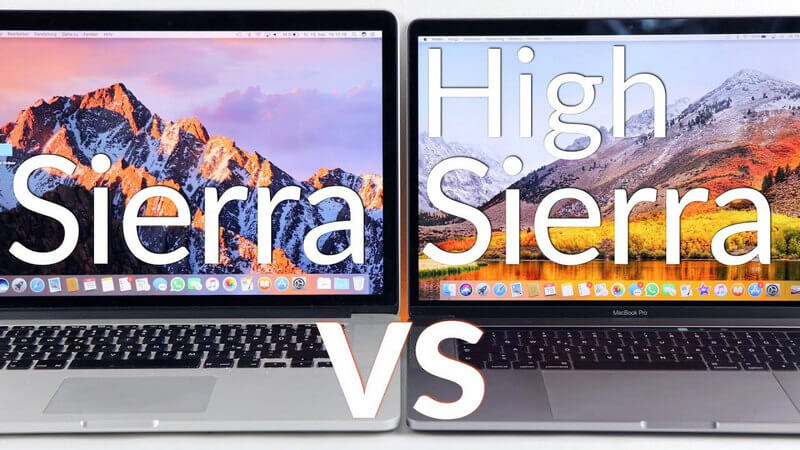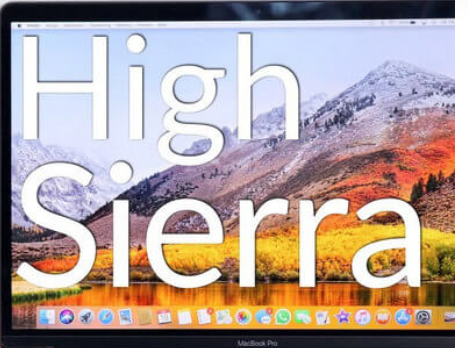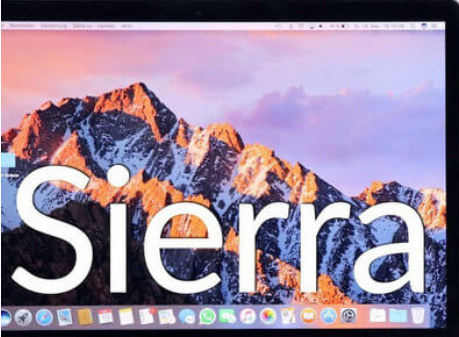macOS Sierra, the latest iteration of Apple’s operating system, introduced a plethora of new features and improvements. While the allure of enhanced functionality and smoother performance may be tempting, upgrading to a new operating system should never be a decision taken lightly. In this blog, we’ll delve into the pros and cons of updating to macOS Sierra, helping you make an informed choice that aligns with your needs and preferences.
Part 1: Is It Worth Upgrading from Sierra to High Sierra?
As of my knowledge cutoff in September 2021, macOS High Sierra is an older version of macOS released in 2017, and it has since been succeeded by several newer macOS versions. Therefore, the decision to upgrade from macOS Sierra to macOS High Sierra might not be as relevant now, as users have the option to update to newer macOS versions like macOS Mojave, macOS Catalina, macOS Big Sur, and potentially even more recent releases.
However, if you find yourself contemplating an upgrade from macOS Sierra to a newer macOS version (whether it’s High Sierra or a more recent one), here are some factors to consider:
Security: The most crucial aspect of upgrading to a newer macOS version is the security enhancements it brings. Apple consistently releases security updates and patches for the latest macOS versions, helping to protect your system from vulnerabilities and potential threats. If you value your data security and privacy, upgrading to a newer macOS is recommended.
Features and Functionality: Each macOS release introduces new features and improvements that can enhance your overall computing experience. These features may include improved performance, better integration with other Apple devices, new applications, and more efficient workflows. It’s essential to research the specific features introduced in the version you are considering and determine if they align with your needs.
Compatibility: When upgrading to a newer macOS version, ensure that your Mac model is compatible with the new OS. As time progresses, some older Mac models may become unsupported, which means they won’t receive software updates or security patches. Check Apple’s official website for the system requirements of the macOS version you’re considering.
Application Compatibility: Ensure that the software and applications you use regularly are compatible with the newer macOS version. Some older or less popular applications may not be optimized for the latest macOS release, potentially leading to compatibility issues or loss of functionality.
Performance: While newer macOS versions often bring performance improvements, it’s essential to verify if the new OS will run smoothly on your Mac. Occasionally, older Mac models might experience performance issues with the latest OS, leading to a less enjoyable user experience.
User Experience: Keep in mind that each macOS version might have a slightly different user interface and user experience. If you’re accustomed to the interface of macOS Sierra, take some time to explore the interface changes in the newer macOS version to ensure you feel comfortable with the new design.
Deciding whether it’s worth upgrading from macOS Sierra to High Sierra (or any newer macOS version) depends on your specific needs, preferences, and hardware compatibility. If your Mac meets the system requirements and you value security, access to the latest features, and improved performance, upgrading to a more recent macOS version is generally a good idea.
However, always remember to back up your data before any major OS update, and consider researching the specific changes and improvements introduced in the version you’re considering to ensure it aligns with your needs. As of my knowledge cutoff, I recommend considering upgrading to a more recent macOS version, as Apple usually provides regular updates and support for the latest two to three versions.

Part 2: The Pros of Upgrading to macOS Sierra
Enhanced Performance: macOS Sierra brings optimizations and refinements that can improve the overall performance of your Mac. Faster app launches, smoother animations, and improved battery life are some notable improvements that could significantly enhance your daily computing experience.
Siri Integration: One of the significant introductions in macOS Sierra is Siri, the intelligent virtual assistant. Having Siri on your Mac allows you to use voice commands to perform tasks, set reminders, check weather forecasts, and more. This integration adds convenience and can be a time-saver for many users.
Auto Unlock with Apple Watch: If you own an Apple Watch, macOS Sierra offers a nifty feature called Auto Unlock. With this, your Mac will automatically unlock when you are in close proximity to it, making it quicker and easier to access your computer without typing your password repeatedly.
Universal Clipboard: With macOS Sierra, Apple introduced the Universal Clipboard feature, which allows seamless copy-pasting between your Mac and iOS devices, making it more convenient to share content across platforms.
Picture-in-Picture: macOS Sierra brings Picture-in-Picture mode, enabling you to watch videos or have FaceTime calls in a floating window while working on other tasks, enhancing multitasking capabilities.

Part 3: The Cons of Upgrading to macOS Sierra
Compatibility Issues: Older Mac models might not be fully compatible with macOS Sierra, leading to potential hardware and software compatibility issues. Before upgrading, ensure that your Mac meets the system requirements for a smooth experience.
Software Incompatibility: Some third-party applications might not work properly or might not be optimized for macOS Sierra, leading to crashes or functionality problems. Check with the developers of critical apps to ensure their compatibility with the new OS before proceeding with the update.
Learning Curve: Whenever there’s a significant operating system update, there’s often a learning curve associated with adapting to new features and interface changes. Some users might find it challenging to adjust to the new system initially.
Bugs and Stability: New operating system releases often come with bugs and stability issues. While Apple usually addresses these through regular updates, early adopters might experience unforeseen issues that could disrupt their workflow.
Dependency on Internet Services: Many of macOS Sierra’s features, such as Siri and iCloud integration, rely heavily on Internet connectivity. Users in areas with poor internet access may find these features less useful or frustrating to use.
Part 4: Sierra vs. High Sierra
“Sierra” and “High Sierra” are two different versions of Apple’s macOS operating system. Let me explain the differences between them:
macOS Sierra (Version 10.12):
macOS Sierra was released on September 20, 2016. It introduced several new features and improvements over its predecessor, OS X El Capitan. Some of the key features of macOS Sierra include:
Siri Integration: Siri, Apple’s virtual assistant, was introduced on the Mac with macOS Sierra, allowing users to use voice commands to perform various tasks.
Universal Clipboard: This feature allows seamless copying and pasting of content between macOS and iOS devices (iPhone, iPad) using the same Apple ID.
Auto Unlock: If you have an Apple Watch, macOS Sierra enables you to automatically unlock your Mac when the watch is in proximity.
Optimized Storage: This feature helps free up storage space by automatically storing infrequently used files in iCloud.
Picture-in-Picture: Users can watch videos in a floating window while working on other tasks.
macOS High Sierra (Version 10.13):
macOS High Sierra was released on September 25, 2017. It is an incremental update over macOS Sierra, focusing on internal improvements and performance enhancements. Some notable features of macOS High Sierra include:
APFS (Apple File System): macOS High Sierra introduced the APFS, which is a modern, more efficient file system, replacing the HFS+ file system used in previous versions.
HEVC Video Support: High-Efficiency Video Coding (HEVC) was introduced, providing better compression for video files while maintaining quality.
Metal 2: An updated version of Apple’s graphics framework, Metal 2, was introduced, offering better performance and capabilities for graphics-intensive applications.
Safari Improvements: Safari received various updates, including improved performance, autoplay video blocking, and intelligent tracking prevention.
Virtual Reality (VR) Support: macOS High Sierra added support for VR content creation and playback.
In summary, macOS Sierra was a more feature-focused update, while macOS High Sierra was primarily aimed at improving performance, and security, and introducing underlying technology like the new file system. By now, newer versions of macOS have likely been released, but these descriptions should give you a general idea of the differences between the two versions as of my last knowledge update in September 2021.
Part 5: Tips before Upgrading to High Sierra
If you’re contemplating an upgrade to macOS High Sierra or any new macOS version, we’ve compiled some essential tips to help ensure a smooth and trouble-free process.
Firstly, check your Mac’s system requirements to ensure compatibility with macOS High Sierra. Keep in mind that not all older Mac models may support the latest macOS version. Next, take the precaution of backing up all your crucial files and data before proceeding with the upgrade. Utilize Time Machine or any other reliable backup solution to create a complete backup of your Mac, ensuring you won’t lose any valuable data during the process.
Verify the compatibility of the essential apps you regularly use with macOS High Sierra. To do this, visit the websites of the app developers and check for updates or compatibility information to avoid any issues after the upgrade.
Before initiating the upgrade, update your current macOS version and all installed apps to their latest versions. This step helps minimize potential compatibility conflicts and ensures a smoother transition. Ensure that your Mac has sufficient free disk space for the installation. macOS upgrades can be sizable, so having several gigabytes of free space is advisable to avoid any disruptions during the process. As a precautionary measure, consider temporarily disabling FileVault (if enabled) and the built-in Firewall. Doing so can prevent potential conflicts during the upgrade process.
Unplug unnecessary external devices such as printers, hard drives, and peripherals before starting the upgrade. This action can help avoid any possible issues with device drivers during the installation. A stable and reliable internet connection is crucial during the upgrade. This is necessary for downloading the macOS High Sierra installer and any required updates.
Connect your Mac to a power source to prevent interruptions during the upgrade process. Keeping your Mac powered throughout the installation ensures a seamless upgrade. Be prepared for the upgrade to take some time, depending on your Mac’s performance and internet speed. Exercise patience and allow the installation process to complete without any interruptions.
Optionally, you can create a bootable USB drive to have a physical installer for macOS High Sierra. This can be useful for future installations or if you encounter any issues and need to reinstall macOS. Once macOS High Sierra is installed, check for any software updates for both macOS and your apps. These updates often include bug fixes and improvements, enhancing the overall performance and experience.
By adhering to these tips, you can significantly increase the likelihood of a successful upgrade to macOS High Sierra, enabling you to enjoy its new features and improvements fully. Remember to verify if newer macOS versions are available when you plan to upgrade, as technology continually evolves. Always check for the latest information before proceeding with any system updates.

Conclusion
The decision to update to macOS Sierra should be based on your specific needs and circumstances. If you have a newer Mac model and desire the latest features and performance improvements, upgrading to macOS Sierra might be a rewarding experience. However, if you rely heavily on critical third-party software or have an older Mac model, it’s essential to weigh the potential compatibility issues against the benefits.
Before making the decision, back up your data to ensure you have a safety net in case of any unforeseen problems during the update process. Additionally, consider waiting a few weeks or months after the initial release to allow time for any major bugs or issues to be addressed by Apple.
Ultimately, whether to update to macOS Sierra or not depends on your comfort level with change, your Mac’s compatibility, and your willingness to embrace the new features and potential challenges that come with a major OS update.
Latest Articles